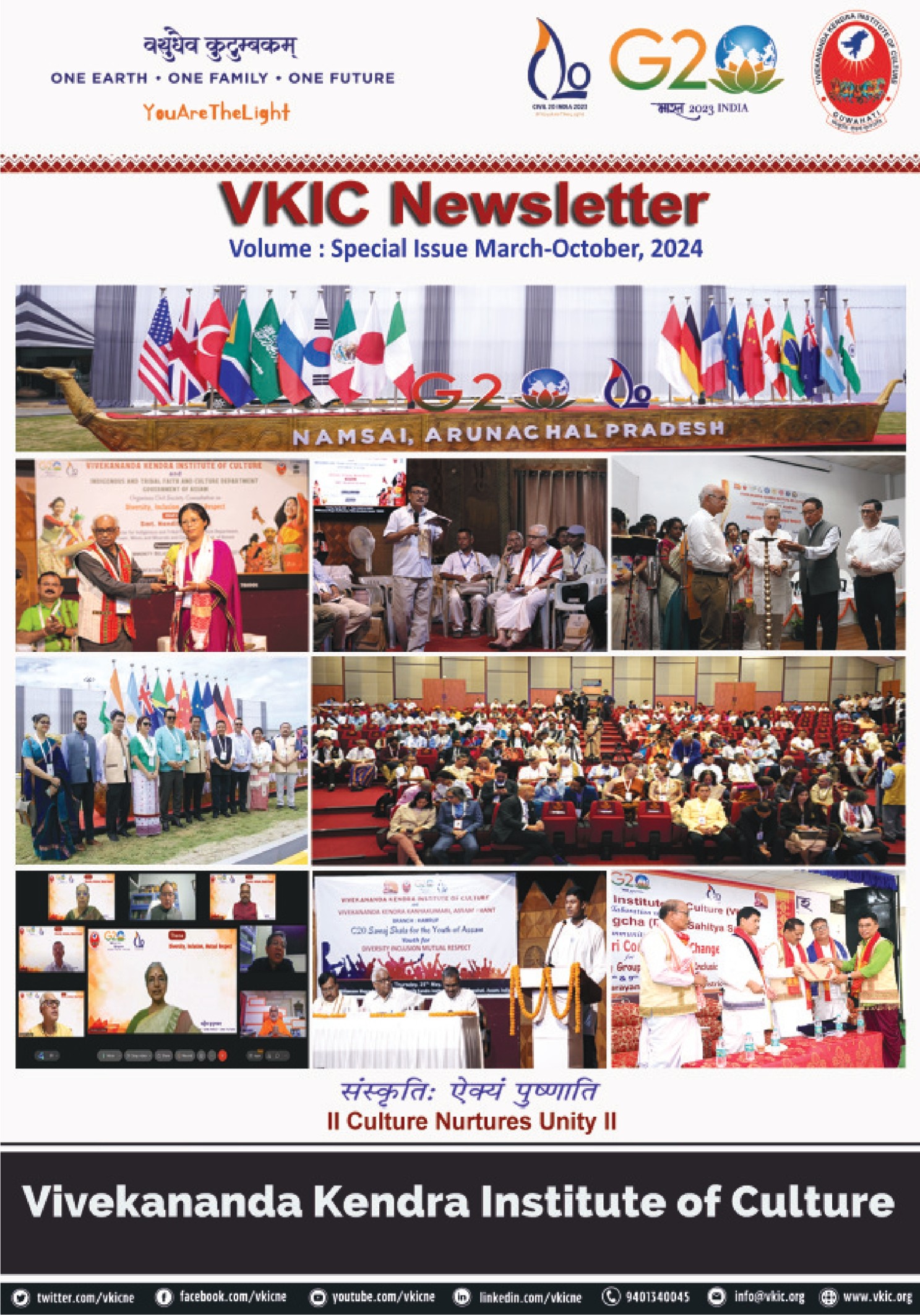Namghar Lecture Series
The VKIC as part of its endeavour to unravel the cultural and social reality of Assam and rest of the Northeast organizes lectures, seminars and workshops on significant traditions and institutions. The year 2014 was marked by a series of lectures on Namghar (traditional community prayer hall) in Assam and adjoining areas. Under the banner of Sankriti Anveshak, these lectures were delivered by persons well-versed in their subjects. The lectures were followed by interactive sessions through which the audience was able to gain more knowledge and insights about a remarkable legacy of Srimanta Sankardeva.
Namghar in the Urban Context of Assam
The Namghars in the urban areas of Assam have successfully retained some of the features of Vaishnavite traditions found in village Namghars. The use of an egalitarian platform to worship one unifying God with prayers and discussions is common to Namghars in cities, towns and villages.
This was stated by Pujyapad Bhadra Krishna Goswami, Sattradhikar of Jokai Sattra in his lecture ‘Namghar in the urban context of Assam’, organized by the Vivekananda Kendra Institute of Culture (VKIC).
According to Goswami, the Namghar became a part of Assam’s urban landscape from the early part of the 19th century. Even though from that time onward modernization brought rapid changes in people’s lifestyles, the Namghar has successfully preserved the basic functions related to Vaishnavite faith and traditions.
The great religious and spiritual traditions started by Srimanta Sankardeva and his disciple Madhavdeva are still maintained by many Namghars in the urban areas of the state. It is within their sanctified spaces the wisdom of the elders is passed on to the younger people.
Mahatma Gandhi had once described the Namghar as a ‘mini Parliament’. Such an ideal survives in the institution in villages as well as in towns and cities. No distinction is made among the faithful coming from different backgrounds. Both men and women have equal access to Namghars.
Referring to the typical architecture of the Namghar, Goswami said that the cardinal principles are adequately followed in building a Namghar in most villages, but are not strictly maintained in towns and cities due to lack of space and other reasons.
During an interactive session, the Sattradhikar underlined the need for facilities in cities which could introduce the young generations about the Namghar and its remarkable history and functions. Apart from spreading faith and spirituality, the young ones will also learn to appreciate their own cultural inheritance. Noted academic Prof. Birinchi K Medhi moderated the session.
Maranga Namghar
The VKIC on June 28, 2014 organised a lecture-cum-interactive session on a historic Namghar situated in Meghalaya.
The Maranga Namghar, in Ri-Bhoi District of Meghalaya continues a cultural tradition that has its origin in Srimanta Sankardeva’s Ek Saran Naam Dharma. Significantly, the faithful have been able to sustain the institution with its historic associations amid adversity over a long period of time.’
In the Namghar, located in an area which was once part Assam, members of the community offer prayers on a regular basis. Around the 20th of every month they offer Sarai. They became associated with the Srimanta Sankar Sangha in the year 1987.
During the session at VKIC the Bhakats from Maranga presented a moving Naam Prasanga after ceremoniously lighting earthen lamps and incense sticks. The audience was impressed by the performance which took place within the confines of an auditorium. They also sang a Borgeet with the same devotional fervour.
The Bhakats of Maranga Namghar said they celebrate the Janmastamai with much enthusiasm. The entire day is spent with Naam Prasanga and religious discussions.
At present 35 families are associated with the Namghar. Even though they reside in a predominantly Christian State, the devotees do not face any hardship. According to the Bhakats they live in harmony with their Christian neighbours.
In the interactive session, eminent Anthropologist and academic, Prof A.C Bhagabati appreciated the efforts of the Bhakats, and especially their service to their Namghar. Cultural activist Dipankar Mahanta and journalist Pulin Kalita moderated the session. Chairman VKIC, Dipok Kumar Barthakur offered a token to the Bhakats as a mark of respect and appreciation.
Sanatan Dharma Namghar
Vibrant facets of a historic temple cum Namghar came alive in a stage performance in the city on August 30. The devotees of Santan Dharma Mandir, Rampur presented several devotional songs and dances to an audience enabling them to get acquainted with a less known but significant cultural heritage.
The programme was part of a lecture cum demonstration series held by the Vivekananda Kendra Institute of Culture (VKIC).
The devotees representing various age groups sang devotional songs, which have been practiced for about 90 years by locals. The songs revealed their firm faith in Vaishnavite religious traditions. The youth of the region have been trained in the art by veterans, a process that continues till today.
A medley of traditional drum (doba) by devotees made an impact on the audience. The beating of the drums differs from one occasion to another. After years of practice, the drummers can change their style to convey different messages to people of surrounding areas. There was even a style of drum beating – a fast and furious rhythm – that spread the message for people to become alert in the face of crisis situations.
Among the favourite items in their repertoire was a performance of Dadhi Manthan, depicting the lovable antics of Lord Krishna. Children associated with the temple enacted a lively scene much to the delight to the audience, which also comprised cultural researchers.
A member of the Santan Dharma temple in his interaction with the audience mentioned that apart from the religious and cultural events, the age old religious centre played a role in furthering education and social awareness on several issues which affect the life of local people. Moreover, the temple also acted as an instrument for settling individual disputes and other contentious issues. The seniors of the temple ensure that honourable settlements are made among stakeholders many a times. Thus peace and harmony is maintained without taking recourse to the law.
Distinguished academic, Prof. A. C. Bhagabati, who presided over the function in his welcome speech introduced the Santan Dharma temple, said that there is much to be learnt from such an old and illustrious institution. Journalist Pulin Kalita and academic Dr Rahul S Mazumdar moderated the session.
Mayamara Namghar
The Mayamara Namghar like Namghars of other communities is a meeting ground for people from different backgrounds, but its egalitarian nature is also reflected in its architecture and locational orientation.
The structure is designed with the idea that the Namghar easily attracts people, is suitable for accommodating large congregations, and can easily hold Bhaonas and other events for the faithful.
This was mentioned by the Yuvadhikar of Dinjoy Sattra, Mukundananda Chandra Goswami while delivering a lecture-cum-interactive session on the Namghar organized by the Vivekananda Kendra Institute of Culture (VKIC) in Guwahati. Held on September 27, this was the eighth lecture in a series on the venerable religious and social institution of Assam.
He stated that the Mayamara Namghar is the outcome of a long evolution right from the time when Sri Sri Aniruddha Dev established a Sattra at Naranpur, in Lakhimpur district. The values and ideals he and his followers stood for are sustained by the present Mayamara Namghar spread across several districts of Assam.
The Mayamara belief system lays great stress on leading a way of life in which good conduct and fellow feeling are placed in high order. Through various vicissitudes, especially political persecution, these principles have enabled the Mayamara Namghar to survive, prosper, and contribute to the religious and social spheres of society.
The session was moderated by Dr B. K Gohain, who emphasised that the Mayamara Namghar can be understood in the historical context of Assam. Noted sociologist Prof Andre Beteille attended the lecture along with a number of scholars. Prof Beteille formally released a VKIC publication on the Rabhas of Assam.
Namghar as an Institution of Self-governance.
Namghars across Assam are synonymous with religious and cultural functions, but many of them are also exemplary in functioning as institutions of self-governance. This was a view expressed by noted researcher Dr Rahul S Mazumdar while delivering a lecture on Namghar in the Vivekananda Kendra Institute of Culture (VKIC), Guwahati, on July 26
In his lecture, Dr Mazumdar portrayed the evolution of the Namghar from inception till the present day. He focused on Namghars in rural and semi-urban areas which still retain many of their age-old traditions and functions. Namghars in such contexts play a significant role in shaping the cultural milieu of adjoining areas. At the same time they exhibit features of self-governance in various ways, allowing people to participate in the decision making process.
According to him, the Namghar in the course of time developed into an institution that governed itself in some clear cut ways. For instance, it had definite ways to gather revenue, keep track of funds, and had functionaries entrusted with specific work to ensure smooth running of the Namghar. He substantiated his views by referring to the functioning of the Barpeta Namghar.
Acknowledging that the Namghar is a dynamic entity that has adapted with changing circumstances, he said that many Namghars have successfully retained the best features which can be traced to its earlier position as a common platform for devotees cutting across social and economic divide. Local people, in their own ways, laid the foundation of many Namghars, and devised methods that enabled its functioning in a way that has withstood the test of time.
Dr Mazumdar hoped that the Namghar would continue to attract study and research particularly in the areas related to its role as a self-governing institution.
Role of Women in the Namghar
The role of women in Namghar has been significant since the time the sacred institution came into existence. It has enabled women to have deep faith in their culture and religion. However, women from the younger generation have not shown much interest in the Namghar as they are not fully informed about its spiritually and culturally emancipating role.
This was a view expressed by noted Sattriya scholar Dr Joyjyoti Goswami during a lecture-cum-interactive session on the Namghar, organized by the Vivekananda Kendra Institute of Culture, Guwahati on November 3.
Dr Goswami, who has extensively researched issues related to the Vaishnavite culture of Assam, focused on the manner in which the Namghar gave valuable space for women to pursue religious and spiritual interests, and over time have helped them to become experts in many areas, including music and arts. In many parts of Assam, women in the Namghar kept alive traditions and cultural values first introduced by Saint Sankardeva.
The Saint and his closest disciple Madhavdeva, Dr Goswami said, played key roles in encouraging women to come together in an atmosphere in which there was no divide of caste and creed. In the Namghar they listened to religious discourse and also created a wide range of songs and verses. In some places they became expert weavers, singers and artistes, revealing their innate talents.
Dr Goswami mentioned that some Namghars, although open to women, have restrictions on the roles they can play. According to a recent survey carried out by researchers in Gauhati University, several Namghars still do not permit the involvement of women to the extent that male devotees are allowed. But in due course as awareness spreads such limitations would be removed, she hoped.
Speaking as the moderator, Dr Nirupama Mahanta, an expert in Sattriya culture said that women can gain a lot by their association with a Namghar. They will not only learn the haloed religious traditions, but also achieve spiritual fulfilment.
She reposed her confidence in the Namghar, reasoning that the institution can give women the faith one needs to overcome trials and tribulations.
The lecture was presided over by Dr Sheila Bora, who spoke on the relevance of Namghar in present times, and its intrinsic connections with women both in towns and villages.


